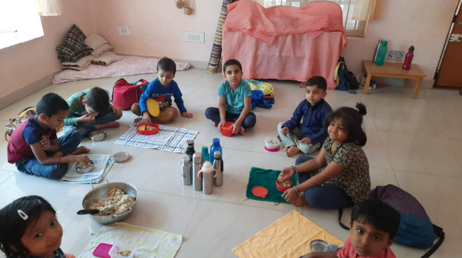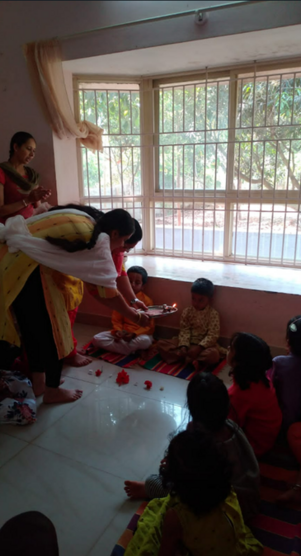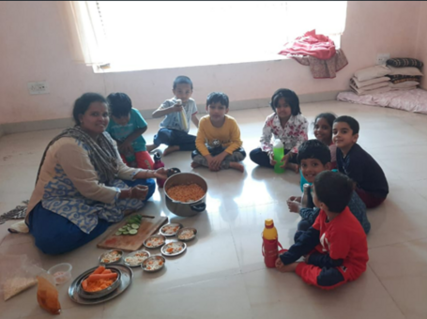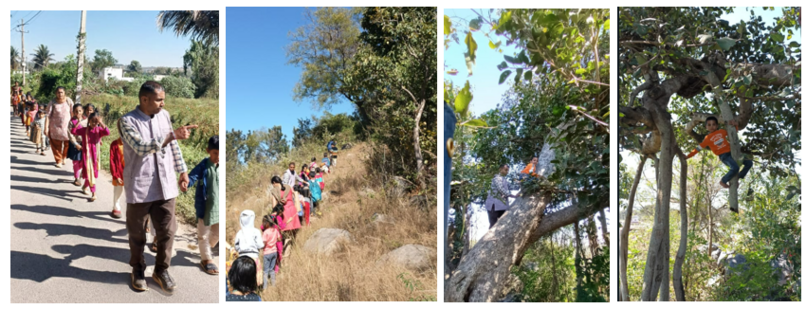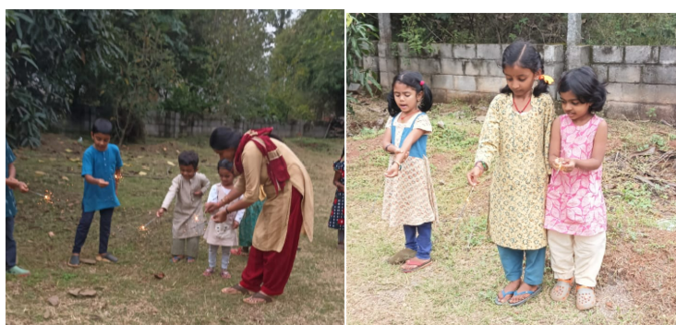Shishuvatika Curriculum
This article is an elaboration of Shishuvatika curriculum at Vidyakshetra.
Introduction
From birth up to 5 years is considered shishuavastha (शिशुअवस्था). This is the age when the developmental focus is on the Annamaya kosha (अन्नमयकोष) and for absorption of knowledge, ‘chitta’ (चित्त) in Anandmaya kosha (आनंदमयकोष), is most active. The mantra for this age is ‘लालयेत् पंचवर्षाणि’ and the goal is to fill the child’s life with love for 5 years.
Shishuvatika, at Vidyakshetra, is an extension of home in many ways. It has a natural, homely atmosphere with motherly adults as its teachers. The environment is made as natural as possible. The main objective is providing good samskaras (संस्कार) to the child of this age whose ‘Chitta’ (चित्त) is just so receptive in this formative stage. These samskaras (संस्कार) become the guiding principles for the child’s life.
The other objectives for Shishu Shiksha (शिशु शिक्षा) at Vidyakshetra-
- Character Building (चरित्र निर्माण)
- Capability Building (क्षमताओं का विकास)
- Provide rich life experiences (जीवन के घनिष्ठ अनुभव देना)
The Annamayya Kosha (अन्नमयकोश) or physical body is made up of panchamahabhootas (पंचमहाभूत). Therefore, panchamahabhootas i.e earth, water, air, fire and sky are the closest to us. A young child has a special relationship with each of these elements. Thus, the child is exposed to the panchamahabhootas through water play, watering plants, wading through waters of stream, sand pit play, clay work, games of blowing air, lighting lamp, cooking on fire etc.
These are provided through the medium of tanmatraas (तन्मात्रा) - by exposing them to rich experiences of roopa (रूप), rasa (रस), gandha (गंध), sparsh (स्पर्श) and dhvani (ध्वनि).
During Prakriti parichaya, they go out in nature and experience the variety of animals, birds, bees, water bodies, hillocks, trees etc. and the exposure is not just restricted to experience of these elements, but the effort is to establish an emotional connect with each element of nature whether it is animate or inanimate. A similar effort is put in their morning circles, during the conversations, through stories and songs etc. to establish an emotional connection with each element of nature. For example, cat becomes billi mausi (बिल्ली मौसी), moon is called Chanda mama (चंदा मामा), brinjal is called baingan raja (बैगन राजा), monkey becomes bandar mama (बन्दर मामा), River Ganges becomes Ganga mata (गंगा माता) etc.
While there is a lot of use of colours, natural wooden toys, plentiful exposure to nature etc, activities to nourishing the Annamayya as well as rich experiences for the child, there is no information or explanation of abstract concepts or reading or writing at this age as the brain is not yet fully developed for this. In the shishuavastha, the physical body is developing which includes the internal organs such as heart, liver, intestines, brain etc. The sign that the development of internal organs is completed, and organs are stabilized, is falling of the milk teeth and growth of arms to cover the head up to the ears. But when children start reading and writing prematurely, energy which is exclusively reserved for the purpose of organ development is diverted for information processing in the brain. When this happens, internal organ development suffers. Therefore, traditionally in Bharat, no formal education was introduced before the age of 7 or 8 yrs of age. Children in shishuavastha stayed at home and they were exposed to home culture, home rhythms, family traditions, family relationships etc. Whatever the child grasped out of its own curiosity from its environment became its education. Therefore, careful attention was given to the environment that the child was growing in and they ensured it was a loving atmosphere, full of vibrancy of our culture, the child was looked upon with lot of love and affection by the family members, proper & timely nourishment was ensured, play was an important part - therefore, in the joint family there were enough and more children around to play with. A very happy childhood experience was ensured for the proper development of its manomaya kosha. Thus, education in this phase is something that is not formal or forced upon but whatever the child grasps naturally out of its curiosity becomes its samskara. As teachers, it is our responsibility therefore, to create such an environment for the child at this stage.
At Vidyakshetra, child is encouraged to wear natural fabric such as cotton. The toys are handpicked, made from natural material such as wood & bamboo. A large play area is made available with fruit bearing trees such as mango and chickoo so the child has vision of auspicious trees and hears melodious sounds of chirping birds, has plentiful exposure to the rays of sun, and cool breezes touch its skin day in and day out. Play area is of utmost importance in this phase as play is nature’s mechanism to exercise the body (remember, Annamayya Kosha is in focus at present) and enable its growth. Children must run around, sweat and play. This keeps them active, ensures good metabolic activity, and therefore good food intake, ensures good growth of all internal and external organs and most of all keeps the child happy.
Classroom Rhythms
Shishuvatika children are at Vidyakshetra from 8:30am to 2:30pm. The day gets planned and divided such that children focus on playing, eating, experiential activities and sleeping in a rhythm. Rhythm means that the instructions are minimal. A naughty child is given no harsh instructions but is gently brought into the right space by the teacher using songs and rhythms which forms the primary part of inculcating disciplinary practices in the child. Rhythms of day, of the week, of the month and of the seasons etc. go deep in its understanding and lays the foundation of good discipline for the child.
There is no scope for harshness, chiding the child or punishing it in shishuvatika as it has a deep bearing on its psyche. In this phase of Lalayet panchavarshani (लालयेत् पंचवर्षाणि), the child needs only love, care, warmth, and affection. Therefore, children are handled with utmost love and care.
A typical time table for the day for Shishuvatika looks like the following:
| Time | Activity |
|---|---|
| 8:30 am | Start of the day |
| 8:30am to 9:00am | Panchanga |
| 9:00am to 10:00am | Class entry rhythm and Breakfast |
| 10:00am to 10:15 am | Morning Circle |
| 10:15am to 11:00am | Activity Time |
| 11:00am to 12:30pm | Play time |
| 12:30pm to 1:15pm | Lunch Time |
| 1:15pm to 2:30pm | Rest Time and leave |
Panchanga (8:30am to 9:00am)
The day starts at 8:30am in the morning. Though Vidyakshetra starts at 7:15am for elder children, Shishuvatika children start their day a little later. They are exposed to daily Panchanga Shravana and an attempt to recite along.
| अद्य्तन पंचांगम,
कल्युगाब्दः द्वाविंशतिः अधिक एक शातोत्तरः पंच सहस्त्रं शालिवानशकः त्रिचत्वारिम्शत अधिक नव शातोत्तर एक सहत्रम प्लव नाम संवत्सरः, दक्षिनायानाम, हेमन्त ऋतुः, मार्गशीर्षः मासः, कृष्ण पक्षः एकादशी तिथिः, गुरुवासरः, विशाखा नक्षत्रं, शुभः योगः, शुभः करणं, इदं दिनं, सर्वेषाम कृते, शुभम् भवतु
वाराद आयुष्य वर्धनम्, नक्षत्राद हरते पापम्, योगाद रोग निवारणं, करणाद कार्य शिद्धिश्च, पंचांग फलम् उत्तमम्, एतेषां श्रुनियो नित्यम्, गंगा स्नानम् फलम् लभेत
|
adytana paṁcāṁgama,
kalyugābdaḥ dvāviṁśatiḥ adhika eka śātottaraḥ paṁca sahastraṁ śālivānaśakaḥ tricatvārimśata adhika nava śātottara eka sahatrama plava nāma saṁvatsaraḥ, dakṣināyānāma, hemanta r̥tuḥ, mārgaśīrṣaḥ māsaḥ, kr̥ṣṇa pakṣaḥ ekādaśī tithiḥ, guruvāsaraḥ, viśākhā nakṣatraṁ, śubhaḥ yogaḥ, śubhaḥ karaṇaṁ, idaṁ dinaṁ, sarveṣāma kr̥te, śubham bhavatu
vārāda āyuṣya vardhanam, nakṣatrāda harate pāpam, yogāda roga nivāraṇaṁ, karaṇāda kārya śiddhiśca, paṁcāṁga phalam uttamam, eteṣāṁ śruniyo nityam, gaṁgā snānam phalam labheta
|
Huge emphasis is given to language development. The child is exposed only to Kannada (the local language & mother tongue of over 90% children in shishuvatika) in this stage of its development. Child is also exposed to Sanskrit shlokas and Bhagavat Gita recitation apart from daily Panchanga shravana.
After Panchanga, children walk back to the class. The class is a little far from Panchanga place. To create a rhythm while walking back, children typically sing a song while walking. The song typically sung is - Puṭāṇi iruve galu naavu, sakkare huduki hoguvevu; saalagi naavu hoguvevu, saalagi naavu maraluvevu (A Kannada poem that says we are tiny ants marching in a straight line looking for sugar). Sometimes repeat this song about three times or sing a combination of songs.
They reach the class by 9:00 am.
Class entry rhythm and Breakfast (9:00am to 10:00am)
It is important to create a rhythm with children in everything they do. The first rhythm is for keeping their things in order. This includes lining the slippers outside the class, do Saraswati namaskar as they enter the class, keep their bags on the self and their water bottles on the table.
Once everybody is settled, lamp lighting with prayers happen. The lamp lighting is done by the teacher and children recite 4 prayers along with the teacher.
- श्री वक्रतुण्ड महाकाय सूर्य कोटी समप्रभा। निर्विघ्नं कुरु मे देव सर्व-कार्येशु सर्वदा॥
- śrī vakratuṇḍa mahākāya sūrya koṭī samaprabhā। nirvighnaṁ kuru me deva sarva-kāryeśu sarvadā॥
- कराग्रे वसते लक्ष्मीः करमध्ये सरस्वती । करमूले तु गोविन्दः प्रभाते करदर्शनम ॥
- karāgre vasate lakṣmīḥ karamadhye sarasvatī । karamūle tu govindaḥ prabhāte karadarśanama ॥
- समुद्रवसने देवी पर्वतस्थानमंडले । विष्णुपत्नी नमस्तुभ्यं पादस्पर्शं क्षमस्वमे ॥
- samudravasane devī parvatasthānamaṁḍale । viṣṇupatnī namastubhyaṁ pādasparśaṁ kṣamasvame ॥
- यानि कानि च पापानि जन्मांतर कृतानि च। तानि सवार्णि नश्यन्तु प्रदक्षिणे पदे-पदे।।
- yāni kāni ca pāpāni janmāṁtara kr̥tāni ca। tāni savārṇi naśyantu pradakṣiṇe pade-pade॥
Then they wash their hands and have their breakfast. Children bring their breakfast from home. The teacher ensure that children are sitting in a mandala on the floor and then having their breakfast. Children are observed to eat slowly, chew well, finish what they brought, wash their boxes and keep them back. The rhythm of doing all this is the key aspect.
This typically gets over by 10:00am.
Morning Circle (10:00am to 10:15 am)
Before starting the activities for the day, children are transitioned into the classroom space with the morning circles. All the children sit in a circle and sing the same song everyday to set started. The song is decided by the teacher. Post that, they greet the nature, do a revision of all the seasons (ऋतु) and sing 3-4 seasonal songs or do a revision of seasonal vegetables.
Morning Cricle is a rhythm of smaller duration but very important to get the class started. This rhythm continues with the children for many years to come, though every subsequent year, the shape and form of it is very different.
If there are any birthdays, they are celebrated during this time. The birthdays are celebrated with lighting the diya, singing the birthday song in Sanskrit, taking blessings from teachers and parents, followed by sweets distribution.
Morning circle rhythm ends at 10:15am.
Activity Time (10:15am to 11:00am)
Man has been gifted with hands to do work and serve others. This samskaar has to be developed right in shishuavastha. It develops through holding, breaking and throwing things. Further, hands develop by playing in water, in sand and soil. To develop the karmendriya called hands, sufficient opportunities are provided in shishuvatika- to clean up after play, to fold clothes, to water the plants, to dig, to sweep, to swab etc. If a child is prematurely introduced to reading and writing, its language development skill of proper pronunciation, tonality, meaning, sentence structuring etc becomes debilitated. So, activities do not include any reading or writing.
The activity time is organized into rhythm of 10 days. So, there are 10 activities and each day there is one activity for the child. These activities are conducted inside the classroom and supervised by the teacher. Activities with 10 days rhythm include the following:
- Drawing with block crayons
- Painting, typically wet on wet painting
- Fireless Cooking (bring ingredients from home) - Includes cutting, pounding, grating, peeling etc which help strengthen the hands.
- Beading
- Nature Walk, to just walk and observe the nature around.
- Krishi (कृषि), to participate in growing something.
- Shrama Daan (श्रम दान), to organize and clean up the classroom environment.
- Finger Knitting, to get control and coordination on their hands.
- Mat Weaving, to get control and coordination on their hands.
- Mud Play
These are repeated in a 10-day cycle, spanning over two weeks. All the activities are made as fun activities to engage each child. Teachers are trained to engage children of different temperament and nature.
If there are any festivals, then they are also celebrated during this time. Below picture shows Diwali celebrations at Vidyakshetra.
The activity time typically ends by 11:00am.
Play time (11:00am to 12:30pm)
Post the activities, it is playing time for children. Play in shishuvatika is a serious affair. This time can be utilized between Indoor and outdoor games. The class teacher decides one of them. After that children play the games of their choice. There is supervision but no instructional regulations. Children form their own groups and play the game of their liking. At Vidyakshetra, we have made the following options available to children:
- Indoor Games
- Wooden toys, dolls, kitchen set
- Skipping
- Wollen balls
- Dupatta tents
- Wooden blocks for house-making, zoo etc.
- Outdoor games
- Sandpit
- MonkeyBar
- Jhoola
- Tree House
- Slide
Children are allowed to get dirty, interact with each other, come back to the teacher to resolve any issues etc.
Play time goes on till 12:30pm.
Lunch Time (12:30pm to 1:15pm)
Lunch is prepared at Vidyakshetra every day. The menu is not decided by the children.
The body (अन्नमय कोष) of the child is developing. Therefore, his nourishment is well taken care of. A balanced menu as per ayurvedic principles has been developed, organic rice, dals and vegetables procured and a roster of parents along with a cook prepare lunch on a daily basis. Such food is offered with love and care to children in shishuvatika.
Though, there is a lunch space in Vidyakshetra, shihuvatika children eat lunch in their own class. They are trained to eat what they are served. Children wash their hands, sit in a mandala and the teachers serve the children. Before starting the lunch, they recite the Bhojan mantra (भोजन मंत्र) along with the teacher:
ॐ सहनाववतु, सह नौ भुनक्तु, सह वीर्यं करवाव है ।
तेजस्वि नावधीतमस्तु मा विद्विषाव है ।।
ॐ शान्तिः शान्तिः शान्तिः ।।
oṁ sahanāvavatu, saha nau bhunaktu, saha vīryaṁ karavāva hai ।
tejasvi nāvadhītamastu mā vidviṣāva hai ।।
oṁ śāntiḥ śāntiḥ śāntiḥ ।।
Every child must take a sufficient portion of lunch. They are encouraged to finish the lunch in the stipulated time, chewing well and finishing all what they have taken. After finishing, they clean up the whole place along with the teacher. Teachers predominantly clean up and children are engaged in the process.
Lunch time typically ends by 1:15pm.
Rest Time and leave (1:15pm to 2:30pm)
It has been a hectic day for the tiny once. It is time to take rest. Children engage in setting up the resting space. They prepare their own bed. Some of them sleep. Children are engaged by the teacher with songs and stories. This also has a rhythm. The same story is told for 1 week. Subsequent week children will tell the story.
They rest till almost 2pm. Post that they prepare to leave for home. They keep their beds back and make the classroom ready for the next day along with the teacher. As they wait to leave Vidyakshetra, they play in sandpit or on tree house. By 2:30pm, they leave by bus or with their parents.
Parent Engagement
All this is aided by deep engagement with parents to educate them as well for the right environment at home. This happens at three levels:
- Arivu (3 times a year)
- Study Circles and Manthan (weekly and monthly rhythms)
- Sameeksha (twice a year)
Arivu
Arivu is a class level discussion. This means that individual children are not the topic of discussion, but class in general is. This happens 3 times a year at one of the parent’s houses on rotation basis. One parent hosts the other parents for a simple dinner. All the parents get an informal environment to interact with each other and the teacher gives a glimpse of the dynamics of ShishuVatika. Behavioural patterns, ways to handle them, support needed from parents, environment changes at home etc. are typical discussion items.
Study Circles and Manthan
All the parents engage in study circle with weekly rhythms of meeting. The content of study circle includes a set of books, videos, visits, expert meetings, writings and presentations. The study circle is lead by the acharya of Shishuvatika, supported by some senior acharyas in Vidyakshetra. The topics range from holistic development, Panchkoshas, Kutumb, samaj, Rashtra, varnashrama, seva, Purushartha, Ramayana, Mahabharata etc. The discussion also involves issues, problems, techniques, tools for shishu avastha (शिशुअवस्था) and how the children transition to baal avastha (बालावस्था). The study circle meets in a weekly rhythm on Saturday. In a month, 3 Saturdays are online meetings and 4th Saturday is an in-person meeting. In-person meetings help do manthan (“मंथन”) of ones understanding of various aspects of life and education for life. The goal of this setup is to bring in the alignment between the understanding of the parents and teachers, so that there is consistency in what the child gets both at home and at gurukul. It is a deep engagement with parents to educate them as well for the right environment at home.
Sameeksha
This is an assessment of a child’s progress and happens as a 1-1 discussion between the parents and the teacher. Panchkosha development, habits, behavior, character etc. gets discussed. If there are learning difficulties for the child or inconsistencies in behavior, they are discussed and possible plan to address those is arrived upon. This Sameeksha happens twice a year.
Conclusion
In an ideal scenario, children should not be sent to Gurukul till the age of 5. They should be at home so that the said home culture, traditions etc. are easily absorbed by the child. Unfortunately, we have a generation of parents who do not know how to make it happen. The situation is addressed with a deep engagement with parents and children for some duration. The hope is that in the next few generations the concept of Shishuvatika will cease to exist. Till then, we continue to create a home away from home for this important phase of the life of a child.
